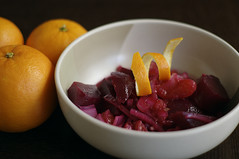January food column, as it appeared in Satellite Magazine:
The holidays are over. For you, maybe it started with the errant Tootsie Roll around Halloween. Maybe you went with a Krackle bar, or maybe you decided to go high-end and demolished a pyramid of Roche ganaches. Chances are, it didn't stop there. The leftover Skittles and Snickers got you through to Thanksgiving. You sat at some familiar table and gorged on turkey, ham (two proteins!), green bean casserole, mashed potatoes, sweet potatoes made with marshmallows, and that cranberry sauce shaped like the can from which it was dumped, unceremoniously. Then you celebrated the end of football season, Hanukah, Christmas, or Kwanzaa, and those latkes aren't exactly low calorie. And now here we are in January, the month of resolutions. That singular time of year when we vow to ourselves that we'll quit bad habits, call our relatives, and be better people. We'll eat salad.
But it's not that easy. Next time you're in the grocery store, check the salad dressing’s ingredients. Not long ago I checked my fridge and found that six out of the seven salad dressings contained high fructose corn syrup, a sweetener that many believe is linked to America’s growing obesity problem. Suddenly that salad doesn't seem so healthy, does it? Not to fear. A healthier salad dressing isn't hard to construct. Not even creamy ranch. And some salads, like the seasonal recipe my sister sent all the way from North Carolina, don't require a dressing at all.
Vinaigrette
Vinegar and oil is perhaps the simplest of salad dressings. In some restaurants, you can still find two stoppered bottles on the tables. But to get a truly good vinaigrette, you have to pay attention to ratios, and it’s best if you have an emulsifier. Once that’s handled, though, you can begin adding additional ingredients to taste.
Ratio: 1 part vinegar to 2-3 parts oil
Emulsifier: A binding agent to hold the two together, however briefly. Mustard works well. As does egg white or even skim milk, though you have to worry about curdling.
Additional ingredients: Honey, lemon juice, salt, pepper, crushed garlic, or shallots.
A fine example might be 2 tablespoons apple cider vinegar, 4 tablespoons olive oil, 1 teaspoon prepared mustard and 1 teaspoon honey. Salt and pepper to taste. Combine all ingredients in a tight-lidded container and shake to combine. Drizzle on your favorite mixed greens.
Creamy dressings
Most creamy dressings are made with mayonnaise or sour cream, but you can often substitute yogurt for a slightly healthier alternative. Begin with 1/2 cup mayonnaise. It’s just eggs and oil. Add 1 tablespoon lemon juice (approximately the juice you’ll get from half a lemon), a little minced garlic, a splash of Worcestershire sauce, and salt and pepper to taste. You now have the base for a number of different dressings.
Add some cracked black pepper and four or five tablespoons of grated parmesan cheese, and you’ve created a wonderful Parmesan peppercorn dressing.
Or, add 2 ounces of crumbled bleu cheese, and you’ve made bleu cheese dressing.
Or, begin with equal parts mayonnaise and buttermilk (1/4 cup each), add 1/4 teaspoon of dried parsley flakes, a pinch of onion powder, a pinch of garlic powder, some dried thyme, and salt and pepper to taste and you’ve got yourself some ranch dressing without ever having to tear open a foil packet.
Any of these dressing formulas will work well for your standard salad of greens, tomatoes and a little cucumber. But those can be tough to find fresh in the dead of winter. However, hearty root vegetables keep a long time, and we’re just entering the end of orange season in Florida, and it’s a perfect time to enjoy this native crop in as many ways as possible. Ann’s beet salad is just one of them.
Beet salad (yummy, yummy)
4 beets
3 oranges
2 teaspoons orange zest
1 small red onion
2 tablespoons extra virgin olive oil
1 tablespoon balsamic vinegar
Salt and pepper to taste
(you may also want to add sugar to the final salad, though the natural sweetness of the orange juice should be plenty)
 Place the beets in a large pot and add water until the beets are covered 1 – 2 inches. Bring the beets to a boil and let them go for about 45 minutes, or until you can easily pass a fork into them. If you need to add water to keep them covered, do so. Drain the beets and shock them in a bath of ice water to stop the cooling process.
Place the beets in a large pot and add water until the beets are covered 1 – 2 inches. Bring the beets to a boil and let them go for about 45 minutes, or until you can easily pass a fork into them. If you need to add water to keep them covered, do so. Drain the beets and shock them in a bath of ice water to stop the cooling process.
While the beets are cooking, peel and cut the oranges, saving the juice (you can probably cut them over a large bowl—perhaps the very bowl you’ll use to serve the salad. Deseed the orange wedges and cut them in half. Zest the peels. Slice the onion thinly and separate the strips.
Bring the beets out of the ice water. Peel the beets (their skins should slide off after cooking) and cut into irregular, bite-sized pieces. In a large bowl, combine the beets, halved orange sections, onion slices, vinegar, oil, and orange rind and mix to combine. Add salt and pepper to taste and sugar if necessary. Let the salad stand for half an hour so the flavors can come together. Garnish with a curled orange rind for a touch of fanciness.



No comments:
Post a Comment